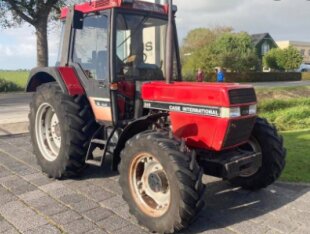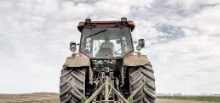________________________________________________________________________________________
| Home / Farm Tractors / Case IH Tractors / Case IH 845XL |
Case IH 845 XL Troubleshooting
 The
Case IH 845XL utility tractor was manufactured between 1987 and 1996. The Case
IH 845 XL driveline consists of International D268 4-cylinder direct injection
liquid-cooled diesel engine and 16x8 IH Total-Synchron fully synchronized
transmission.
The
Case IH 845XL utility tractor was manufactured between 1987 and 1996. The Case
IH 845 XL driveline consists of International D268 4-cylinder direct injection
liquid-cooled diesel engine and 16x8 IH Total-Synchron fully synchronized
transmission.
A 268 cubic inches (4.4 L) engine has a cylinder bore of 3.94" (100 mm), piston stroke of 5.5" (140 mm), and rated power of 80 hp (59.7 kW). The maximum forward speed - 10.8 mph (17.4 km/h), maximum reverse speed - 18 mph (28.9 km/h).
The open center hydraulic system includes a gear pump with rated fluid flow of 8.7 gpm (32.9 lpm). The hydraulic system pressure is 167 bar (2420 psi). The Case IH 845XL is equipped with a hydrostatic power steering, wet disc brakes, 10.0-R16 (2WD) or 11.2-R28 (4WD) front tyres, and 18.4-R34 rear tyres. The wheelbase is 94.1" (2390 mm) for 2WD tractors and 92.5" (2340 mm) for 4WD tractors.
| Engine Troubleshooting |
| Engine starts hard or will not start |
Air in the fuel lines - Bleed the fuel lines.
Dirty fuel filter - Replace filter element.
Dirty or damaged injection nozzles - Check injection nozzles and replace if required.
Dirt or water in fuel system - Drain water or flush dirt from the system.
Valve clearance is out of adjustment - Have it adjusted.
Defective fuel injection pump - Repair or change injection pump.
| Diesel starts but stalls suddenly |
Air filter clogged - Carry out maintenance on air filter.
Fuel filter plugging - Change filter element.
Fuel injection pump is leaking - Repair any leaks.
Dirty or defective injectors - Change or clean fuel injectors.
Fuel injection pump failure - Repair or replace injection pump.
| Diesel shuts off while driving |
Engine is not fully warmed up - Engine is not warmed up to the required temperature.
Fuel filter plugged - Install new filter element.
Air in fuel tank - Bleed fuel tank.
Damaged or dirty injection nozzles - Clean or change injection nozzles.
Wrong setting of fuel injection pump timing - Adjust as recommended.
| Engine shuts off while idling |
Incorrectly adjusted low idle speed - Adjustment required.
Fuel injection pump is not operating properly - Rebuild or install a new injection pump.
Dirty or defective injectors - Replace fuel injectors.
Valve out of adjustment - Need to adjust valve clearance.
| Poor engine power |
Air cleaner is dirty - Air filter maintenance required.
Fuel injection nozzles are faulty or clogged - Install a new kit of correctly balanced nozzles.
Incorrect fuel injection pressure - Check the fuel injection pressure and adjust if necessary.
Valve clearance is wrong - Adjust valve clearance.
Incorrect low idle setting - Test and adjust.
Dirt in the fuel lines or hoses - Service fuel lines and hoses.
Cylinder head gasket is damaged - Replace the gasket as required.
Piston rings are defective or leaking - Piston rings replacement required.
| Engine is overheated |
Engine has a lack of coolant - Fill radiator to proper level and check components for faults.
Engine oil level is insufficient - Fill the crankcase with engine oil.
Radiator core is clogged or radiator cap is leaking - Clean radiator or install new cap.
Broken or loose fan belt - If necessary, replace the belt.
Engine is under excessive load - Reduce load on the engine.
| Low oil pressure |
Lack of oil - Add oil as required.
Oil filter is clogged - Replace or service engine oil filter.
Improper type of engine oil - Drain crankcase and refill with correct oil.
Excessive oil clearance of crankshaft bearing - Change bearings.
Defective oil pump - Replace as required.
| Engine noise or knocking |
Low engine oil level - Need to add engine oil.
Engine not warmed up - Warm up engine as required.
Wrong setting of fuel injection pump timing - Adjust the pump as required.
Incorrectly set low idle speed - Adjustment required.
Clogged or defective injectors - Clean fuel injectors or change it.
Connecting rod is worn or misaligned - Need to align or replace the connecting rod.
Scored or worn pistons - Replace the pistons as required.
| Transmission Troubleshooting |
| Lack of transmission oil pressure |
Transmission oil level is low - Fill the transmission housing with oil.
Transmission oil filter is clogged (if fitted) - Clean or replace the transmission filter.
Stuck relief valve - Change relief valve.
| Excessive transmission noise |
Lack of transmission oil supply - Fill the transmission housing with oil.
Transmission oil is contaminated - Transmission oil change required.
Gears are defective or backlash is improper - Replace gears or adjust backlash correctly.
Worn or damaged bearings - Faulty bearings should be changed.
Shift forks are worn or bent - Replace defective shift forks.
Shaft splines are damaged or worn - Replace the shaft.
| Hard to shift gears |
Corroded or worn gear shift linkage - Install new shift linkage.
Damaged or worn gear shift forks - Replace defective shift forks.
Gearshift mechanism is damaged - Replace or repair the mechanism.
Clutch is out of adjustment or defective - Clutch needs to be adjusted or changed.
| Transmission fluid leakage |
Transmission fluid level is exceeded - Excess fluid must be drained.
Seals or gaskets are broken - Gaskets or seal need to be replaced.
| Hydraulics Troubleshooting |
| Hydraulic oil pressure is low |
Low hydraulic oil level - Check and refill the hydraulic oil.
Hydraulic oil filter is clogged - Clean the hydraulic filter or install new filter element.
Hydraulic pump is faulty - Repair or replace hydraulic oil pump.
Hydraulic spool valve is not set properly - Set the spool valve properly.
Damaged hydraulic cylinder - Repair or change hydraulic cylinder.
Leaks in hydraulic lines - Check the system and repair leaks.
| Hydraulic system is overheated |
Main relief valve is faulty - Relief valve need to be replaced.
Wrong hydraulic oil type - Fill up with the correct type of oil.
Contaminated hydraulic fluid - Change hydraulic fluid.
Air in the hydraulic system - Air bleeding.
| 3-point hitch fails to lift or lifts slowly |
Excessive hitch loading - Reduce hitch load.
Insufficient hydraulic fluid - Add fluid as required.
Dirty hydraulic fluid filter - Service or replace the hydraulic filter.
Defective hydraulic pump - Install a new hydraulic oil pump.
Main relief valve malfunction - Relief valve need to be replaced.
Hydraulic spool valve is faulty - Replace or repair the valve.
Hydraulic cylinder is defective - Change or repair hydraulic cylinder.
Suction pipe is loose or broken - Repair or replace pipe.
| Hitch cannot be dropped or dropping is too slow |
Incorrect setting hydraulic control valve - Use the correct adjustment.
Broken hydraulic cylinder - Repair or change hydraulic cylinder.
3-point hitch is out of adjustment - Adjust as required.
Damaged hitch cross shaft - Replace the shaft.
| Jerky lowering or lifting of the hitch |
Air in hydraulic pipes - Bleed hydraulic pipes.
Hydraulic fluid is contaminated - Fill up with new hydraulic fluid.
Defective hydraulic pump - Change or repair hydraulic oil pump.
Hydraulic spool valve is faulty - Repair or change the valve.
Damaged hydraulic cylinder - Install a new hydraulic cylinder or repair it.
| Steering System Troubleshooting |
| Steering is hard |
Defective or incorrectly mounted steering column - Change steering column or mount correctly.
Air in steering hydraulic system - Bleed the steering system.
Not adjusted toe-in - Adjust toe-in wheels.
Uneven tyre pressure - Inflate the tyres properly.
Steering pump failure - Repair or change steering pump.
Steering pump control valve is worn or stuck - Service or change control valve.
Steering fluid level is insufficient - Add oil to steering system.
| Steering wheel has too much free-play |
Steering column shaft or coupling has maximum wear - Replace faulty component.
Steering pump failure - Repair or replace steering pump.
Worn or loose steering linkage joints - Check and change as required.
| Front wheels wander to right or left |
Front tires are worn unevenly - Install new tires.
Improper toe-in - Adjust toe-in wheels.
Worn or loose steering linkage assembly - Inspect and change as required.
Defective or improperly adjusted front wheel bearings - Replace the bearings or adjust it properly.
| Electrical Troubleshooting |
| Battery will not charge |
Electrical cable connections are corroded or loose - Service or tighten cable connections.
Electrical terminal connectors are defective - Terminal connectors need to be changed.
Battery is worn - Battery change required.
Worn or loose belt - Change belt or adjust belt tension.
| Starter turns slowly |
Low battery capacity - Low battery charging, charge as required.
Battery discharges quickly - Service charging system or install new battery.
Battery terminals are corroded or wires are disconnected - Connect wiring properly or install new terminals.
| Starter motor is not working |
Battery is drained or defective - Battery needs to be recharged or replaced.
Disconnected or incorrectly connected wires - Inspect battery wires and connect correctly.
Low battery output voltage - Battery is drained, recharge it.
Starter motor is faulty - Repair or replace starter.
________________________________________________________________________________________
________________________________________________________________________________________
| Farm Tractors Technical Specifications |
